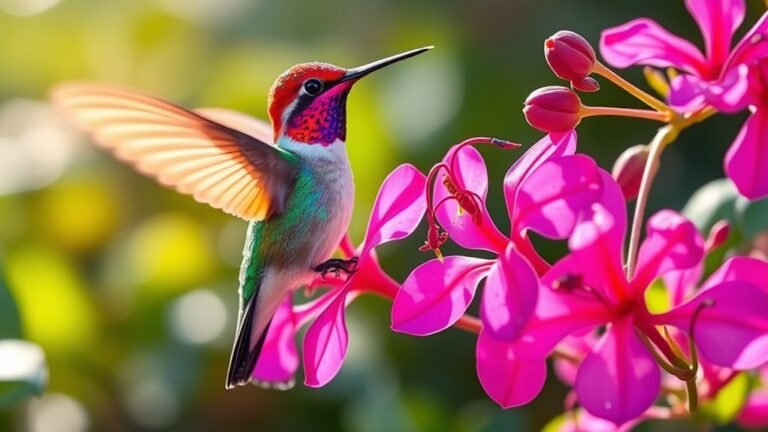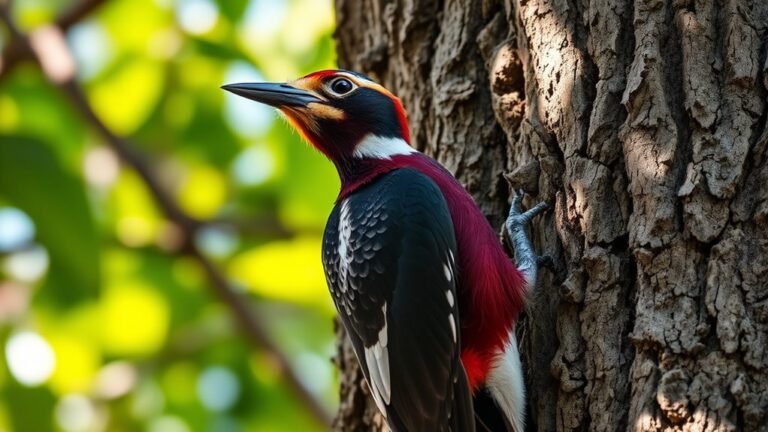What Does a Female Oriole Bird Look Like? Identifying This Bright Beauty
When you see a female oriole, notice her yellow and brown feathers. Her colors are less bright than the male's. She is compact, about 7 to 8 inches long, with a rounded body and shorter wings. Look for the dark line from her beak to her throat; this is important for identifying her. Knowing these details can improve your bird-watching experience. There is much more to learn about her behaviors and habits. Enjoy observing her in her natural habitat.
Key Takeaways
Female orioles have a subtle mix of yellow and brown colors, which makes them less bright than the males. They measure about 7 to 8 inches long. Females have rounder bodies and shorter wings compared to males.
They have a distinctive dark line that runs from their beak to their throat. Their slender, pointed beak and tapered tail help them fly quickly and catch insects with ease.
You can usually find female orioles in wooded areas. They are social birds, known for their sweet whistles and sharp calls, which add to the lively sounds of their environment.
The Female Oriole's Color Palette
The female oriole has a color palette that's subtle yet captivating. She displays muted yellows and grays, which mix with shades of brown. This combination creates a different look compared to male orioles, who showcase bright orange and bold black.
The differences in their plumage are notable. Females have soft, creamy underparts, a dark crown, and a lighter back. This design helps the female oriole blend into her environment, balancing beauty with functionality.
As you learn to recognize the female oriole, appreciate her unique colors. They reflect her important role in nature. The beauty of her palette lies in its simplicity and elegance.
Size and Shape Comparison to Male Oriels
Understanding the female oriole's colors helps us look at her size and shape.
Female orioles are about 7 to 8 inches long. Males are larger, measuring 8 to 9 inches. This size difference is important. The shape also varies between males and females.
Females have rounder bodies and shorter wings. Males have longer, sleeker shapes. The female's softer outline helps her blend in, especially when nesting.
Recognizing these differences will improve your ability to identify these beautiful birds and increase your appreciation for them.
Distinctive Markings and Patterns
When you see a female oriole, notice her unique markings and patterns. Her slender body has feathers in muted yellows and browns, giving her a more natural look compared to the bright male.
Look closely at her face; a dark line runs from her beak to her throat, adding to her distinct appearance. These features help you tell her apart from other similar birds.
Observing these details makes birdwatching enjoyable and allows you to appreciate the beauty of each female oriole in the wild.
Beak and Tail Features
To identify a female oriole, focus on her beak and tail features. Her beak is slender and pointed, ideal for catching insects and sipping nectar. This shape helps her thrive in various environments.
Next, notice her tail, which is long and tapered. This tail design aids in agile flight and quick turns. The tail feathers may have slight color variations, blending with her muted plumage.
Together, the beak and tail create a distinct silhouette, helping you tell her apart from other species. Observing these details will enhance your appreciation for the female oriole's beauty and connect you with avian life.
Habitat Preferences of Female Oriels
Female orioles prefer wooded areas that offer shelter and food.
They're often found in deciduous forests and riparian zones where insects and fruits are abundant. These birds thrive in environments with dense foliage, allowing them to nest safely from predators.
They also enjoy backyards with fruit-bearing trees and shrubs. Gardens are attractive to these colorful birds.
Behavior and Vocalizations
Female orioles prefer specific habitats that affect their behavior and vocalizations. These birds are often social and can be seen foraging in pairs or small groups. This social behavior improves their feeding.
Their vocalizations include sweet whistles and sharp calls. These sounds help them communicate and stay together. When you watch them in your backyard, notice how they call to each other while looking for nectar or fruit.
These vocal interactions strengthen their social bonds and help them find food, which is vital for their survival.
Seasonal Variations in Appearance
As the seasons shift, female orioles change their plumage significantly.
In the breeding season, their feathers shine with bright yellows and subtle oranges. These colors help them attract mates and establish territory.
In autumn and winter, their plumage turns to muted shades of brown and olive. This change offers better camouflage from predators and environmental shifts.
These seasonal changes help orioles survive and show their adaptability.
Observing these transformations allows you to appreciate their resilience and beauty in nature.
Mimicry and Camouflage
Female orioles use mimicry and camouflage to stay safe in their environment. They imitate calls of other birds to mislead predators.
Their colors, mostly brown and yellow, help them blend in with branches and leaves. This ability to blend in not only protects them but also helps them find food.
Watching a female oriole in nature shows how well she combines these skills, balancing being seen and hidden. These traits highlight their survival strategies, allowing them to thrive in various habitats.
Importance of Females in Nesting and Parenting
In the fascinating lives of orioles, female birds play a crucial role in nesting and raising their young.
Female orioles build the nest by gathering and arranging materials like grasses, fibers, and spider silk. This careful building creates a safe place for their eggs and chicks.
After the eggs hatch, the female oriole is deeply involved in caring for her chicks. She feeds them and protects them from harm.
The female and male orioles work together during this time. While she takes care of the young, the male often defends their territory.
This teamwork highlights how important female orioles are for the survival of their species and the continuation of their families.
Tips for Spotting Female Oriels in the Wild
Spotting female orioles can be difficult because they've less bright colors than the males.
Look for their subtle yellow and olive shades. Observe their behavior: female orioles often search for food in trees or shrubs. They might hang upside down to get insects or nectar from flowers.
Listening for their soft calls can also help you find them. When you see them among the colorful leaves in gardens or parks, it enhances your birdwatching experience and connects you to nature.
Frequently Asked Questions
Do Female Orioles Migrate, and if So, Where To?
Yes, female orioles migrate to warmer areas. They move from northern breeding grounds to Mexico and Central America. They follow migration paths that help them find food and good nesting sites.
How Long Do Female Orioles Typically Live in the Wild?
In the wild, female orioles generally live for 2 to 5 years. Their lifespan often depends on the quality of their habitat and the presence of predators. These factors significantly affect their chances of survival in different environments. Understanding these elements can help bird enthusiasts appreciate the lives of these vibrant birds.
What Do Female Orioles Eat in Their Natural Habitat?
Female orioles eat nectar from flowering plants. They especially enjoy trumpet vine and orange blossoms. Their diet also includes fruits and insects. These foods provide the nutrients they need to stay vibrant and active.
What Are Common Predators of Female Orioles?
Female orioles face threats from predators like hawks and snakes, especially during nesting. They build nests high in trees to stay safe. Their alert behavior helps them spot danger. These strategies increase their chances of survival in their environment.
How Can I Attract Female Orioles to My Backyard?
To attract female orioles to your backyard, follow these simple steps. Place feeders close to fruit-bearing trees. Offer a variety of fruits, including oranges and berries. Watch their behavior to improve your setup, creating a friendly atmosphere for these colorful birds. Enjoy their presence and beauty in your garden.

Ava is a bird enthusiast and nature lover who has spent countless hours observing and learning about the fascinating world of birds. With a passion for sharing her knowledge and inspiring others to appreciate the beauty of birds, Ava writes about her experiences and insights on avianadmirer.com.







